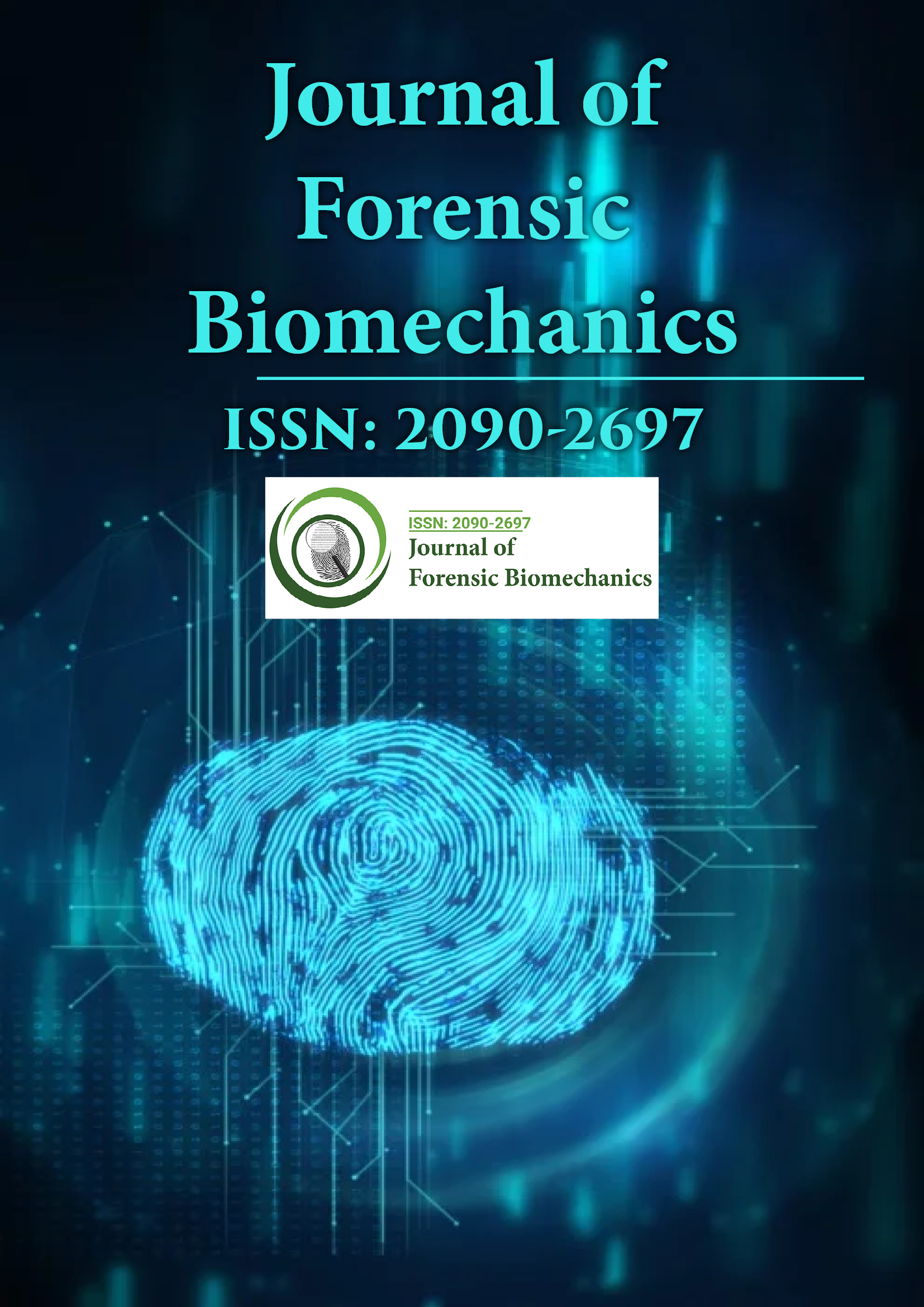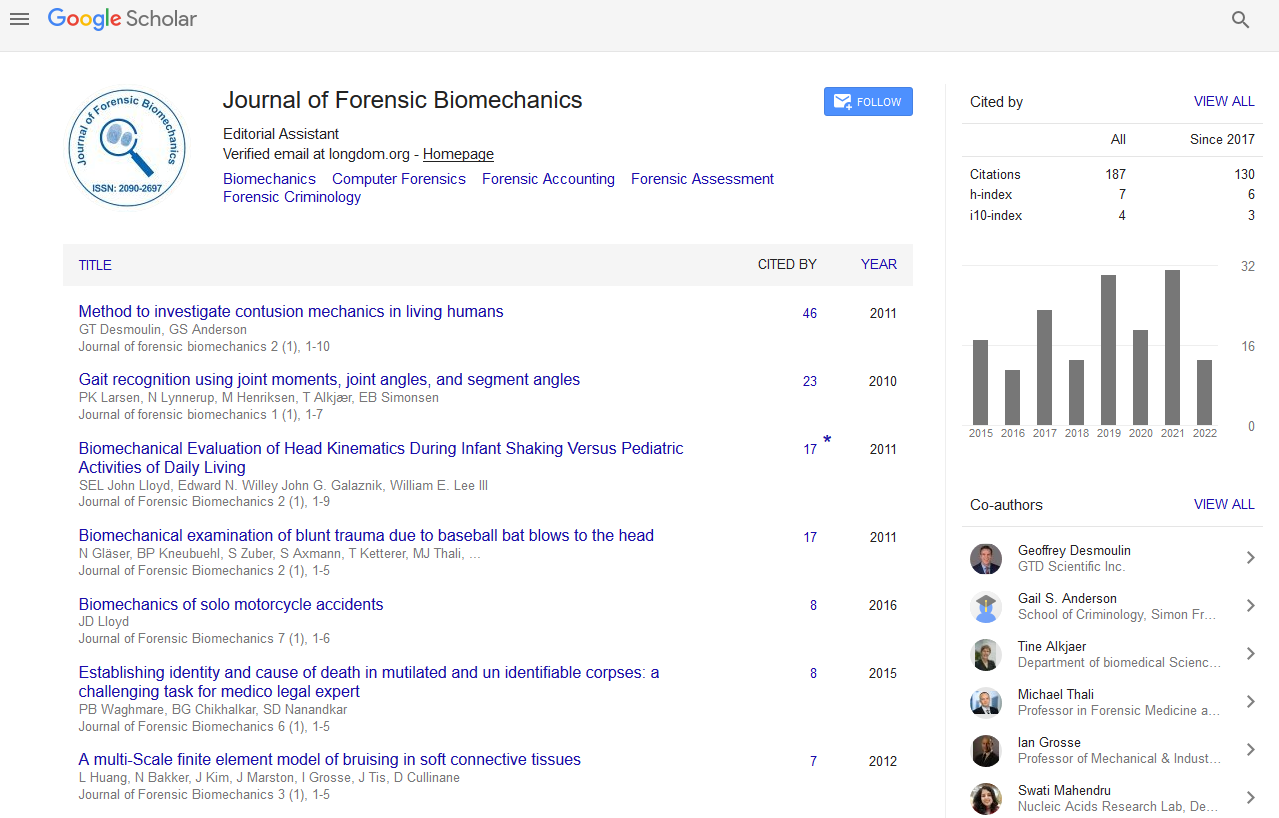Indexed In
- Genamics JournalSeek
- SafetyLit
- Ulrich's Periodicals Directory
- RefSeek
- Hamdard University
- EBSCO A-Z
- Geneva Foundation for Medical Education and Research
- Euro Pub
- Google Scholar
Useful Links
Share This Page
Journal Flyer

Open Access Journals
- Agri and Aquaculture
- Biochemistry
- Bioinformatics & Systems Biology
- Business & Management
- Chemistry
- Clinical Sciences
- Engineering
- Food & Nutrition
- General Science
- Genetics & Molecular Biology
- Immunology & Microbiology
- Medical Sciences
- Neuroscience & Psychology
- Nursing & Health Care
- Pharmaceutical Sciences
Commentary - (2022) Volume 13, Issue 2
Role of Odontology in Forensics
Received: 01-Mar-2022, Manuscript No. JFB-22-16067; Editor assigned: 03-Mar-2022, Pre QC No. JFB-22-16067(PQ); Reviewed: 17-Mar-2022, QC No. JFB-22-16067; Revised: 22-Mar-2022, Manuscript No. JFB-22-16067(R); Published: 29-Mar-2022, DOI: 10.35248/2090-2697.22.13.394
Description
Dentistry is the study of teeth. Dentists examine their development and illness and analyze their structure. Odontology is a dental specialty that helps identify unknown bodies and associate bites with specific individuals. The judiciary can use dentistry to resolve crimes and identify victims. It is also called as forensic dentistry which is a field of forensic medicine and applies it to support criminal investigations. Dentistry often includes postmortem dental examinations, including mapping of cranial and tooth features with the use of digital imaging and x-ray recording in-order to create a detailed report [1]. Odontologists combine the work of dentists, forensic scientists, and police investigators. While dentists specialize in dental treatments such as filling worms and removing damaged teeth, most dentists work for local or state governments as part of a medical evaluation team. They can move to a criminal scene or accident scene and work outside with different weather conditions [2].
Responsibilities of odontologists
Evaluate the age of skeletal remains. Forensic dentists can analyze skeletal prostheses and assess their age based on tooth condition compared to typical tooth development [3].
Testify in court cases: Odontologists may testify when accompanied by medical malpractice or other criminal activity.
Identify bodies: At the scene of the accident, a forensic dentist tries to identify the body of the victim after the disaster. If face recognition or fingerprinting is not possible, their help is very important. They can see evidence such as Tooth debris that other medical professionals may miss
Visit crime scenes: Forensic dynamics support the criminal judicial to find suspects in different cases. Some of the discoveries of the suspects include visits for treasures scenes for finding teeth and other clues.
Attend autopsies: Forensic dyes have been able to visit autopsy. During this process, the task includes measurement, plastic shape, X-ray and photographs, and involves identifying debris as compared to the dental record of those lacking.
Analysis of Bite: The dye scholar can analyze crime field analysis, and identify the occlusal pattern of food that can be found in the victim's skin. They also examine the mark of the suspicious sample occlusion and identify an attacker. Autologist can interpret whether bites mark is aggressive or defensive.
Collecting and analyzing the evidence of dentists: Foreign substances are used to collect dental evidence from various sources and identify suspects and victims. They can extract saliva that can be used as evidence or deploy DNA. Autologist can also use occlusal impression. These evidences help to estimate person's age and narrow the list of suspects.
Forensic dentists make analysis and conclusions based on how the teeth were over time, how the teeth are placed in the mouth, and the traces left by the teeth. Also, look at dentures, bridges, crowns, braces, and fillings to identify the owner [4].
Uses of Forensic Odontology
Forensic dentistry law in criminal cases is becoming more and more controversial in the use of criminal court proceedings.
Dental evidence can be used in a variety of ways. First; there is the age determination. This can be determined based on the size and shape of the tooth, the dentition, or the transparency of the root. Dating is often used to find human bodies in archaeological sites. The second is identification; forensic dentistry is especially useful in the major disaster or when facial recognition is not critical. Teeth are one of the hardest substances in the human body and can withstand chemicals, fire, or other substances that accelerate the decay of the human body. The third is byte mark analysis; this begins with ensuring that the impression marks left by human teeth can be identified. In addition, the nature of the teeth is partly deeper, but it is the fourth abuse. Sexual abuse accounts for the majority of child abuse, of which tooth decay is an excellent indicator. Dentists often see torn prepuce in children less than 6 months of age or in children who are already in motion. This suggests some form of abuse, such as slap in the mouth or force-feeding [5].
Conclusion
The work of a dentist is very detailed, requires very fine motor skills, and requires extraordinary accuracy and precision, complex equipment, including computers, microscopes and other technologies can be used in the identification process. In forensic dentistry, you need to pay attention to the details, work patiently, and rush to complete the time-consuming, step-by-step process. Forensic dentists must be able to draw conclusions based solely on the physical evidence available. Forensic dentists need to keep accurate and complete records. Very close involvement in the investigation of crimes and catastrophes can be emotionally disturbing.
REFERENCES
- Kavitha B, Einstein A, Sivapathasundharam B, Saraswathi T. Limitations in forensic odontology. J Forensic Dent Sci. 2009;1(1):8-10.
[Googlescholar], [Crossref]
- Verma AK, Kumar S, Rathore S, Pandey A. Role of dental expert in forensic odontology. Natl J Maxillofac Surg. 2014;5(1):2-5.
[Googlescholar], [Crossref], [Pubmed]
- Avon SL. Forensic odontology: The roles and responsibilities of the dentist. J Can Dent Assoc. 2004;70(7):453-458.
[Googlescholar], [Pubmed]
- Acharya AB. Teaching forensic odontology: An opinion on its content and format. Eur J Dental Educ. 2006 Aug;10(3):137-141.
[Googlescholar], [Crossref], [Pubmed]
- Shamim T. Forensic odontology. J Coll Physicians Surg Pak. 2010;20(1):1-2.
[Googlescholar], [Pubmed]
Citation: Yoshida H (2022) Role of Odontology in Forensics. J Forensic Biomech. 13:394.
Copyright: © 2022 Yoshida H. This is an open-access article distributed under the terms of the Creative Commons Attribution License, which permits unrestricted use, distribution, and reproduction in any medium, provided the original author and source are credited.

